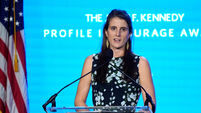Celtic Sea provides a boost for cod
A study being carried out by the Marine Institute in the Celtic Sea is showing that cod can grow quickly and to large sizes there. Thousands of tagged cod have been released there with the aim of determining conditions for the fish around the Irish coast.
Scientists have been warning that North Sea cod are in danger of dying out without a complete fishing ban. Well over 80% of cod caught in European waters is eaten in Britain and Ireland You might have noticed in recent years, however, that cod is not as available in fishmongers and supermarkets as it once was. It has long been a favourite, whether served in batter with chips, included in fish pies, or given the full restaurant treatment.
But our taste for cod has dangerously depleted stocks. Tight fishing quotas were introduced in 2004 and campaigners have urged retailers to sell only cod from sustainable sources. Much of the cod now consumed in western Europe is from sustainable sources, such as Iceland, the Barents Sea, or from the Baltic, where over-fishing has not been such a problem.
Meanwhile, the joint project between the Irish fishing industry and scientists from the Marine Institute to track stocks of cod in the Celtic Sea is starting to yield interesting results. Funded with monies administered under the Bord Iascaigh Mhara (BIM) National Development Plan over the last two years, 4,000 cod have been tagged and released by Marine Institute scientists working aboard commercial fishing vessels from Dunmore East. The fish were taken from the Waterford Estuary, 20 to 60 miles offshore, tagged and fitted with a recording device.
The project is designed to study the growth and migration of both the inshore juvenile fish and the offshore adult spawning stock. To date, around 10% of the tagged fish have been returned by a combination of fishermen, anglers and processors from Ireland, UK, Spain and France, according to Macdara O Cuaig, a scientist with the Fisheries Science Services team of the Marine Institute.
“What makes this project such a success is that every fish that is recaptured and reported adds its own piece of information to the jigsaw and helps us get a better understanding of the stock, he explained. Electronic data storage tags (DTS tags) are surgically inserted into the gut cavity of the fish. The tags record time, temperature and depth of the environment surrounding the fish while it is at sea. Each DST tag deployed to date has been set to measure temperature and depth every four minutes for a period of up to two years.
Once retrieved, they can yield valuable information about the behaviour of the fish over time by comparing the data recorded by the DST with known temperature and depth data for the area. This allows the scientists to calculate where the fish has been between the release and recapture position, which in turn builds an accurate picture of the migration patterns and associated growth of the stock.
The tracking of one individual fish recently not only confirmed the rapid growth associated with Celtic Sea cod, but this particular fish also had the distinction of being caught three times and released twice. The fact that this fish had grown 33 cm in 15 months showed that Celtic Sea cod have high growth rates – in this case an almost nine-fold increase in weight in the first 10 months since its initial release, followed by a slower but still significant increase over the next five months to 1.9 kilos.
“This fish had a 16-fold increase in weight in just 15 months. This demonstrates the potential yield possible from the Celtic Sea cod stock,” Mr O Cuaig pointed out.
The Food and Agriculture Organisation of the United Nations has warned that three-quarters of commercially valuable fish stocks around the world are over-exploited, and that 90% of species such as cod and swordfish have already been lost But buying cod from where supplies are, for now, plentiful is not the answer. That simply shifts pressure around the globe, scientists tell us. Nor is it simply a matter of eating different types of fish. Environmental campaigners want a ban on beam-trawling, which drags heavy nets along the seabed – 70% of what’s caught is thrown back, dead or dying, and at-risk.
A major, international scientific study has shown there will be virtually nothing left to fish from the seas by the middle of the century if current rends continue.
“The way we use the oceans is that we hope and assume there will always be another species to exploit after we’ve completely gone through the last one,” said research leader Boris Worm, from Dalhouse University, in Canada. “What we’re highlighting is that there’s a finite number of stocks: we’ve gone through one-third and we are going to get through the rest,” he added.














